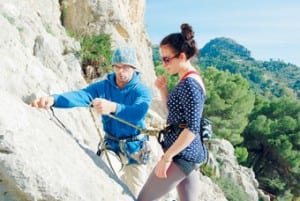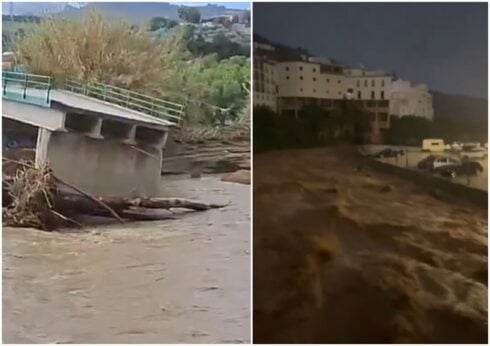By Eloise Horsfield
Right up there with Kalymnos Island in Greece and Fontainebleau in France, El Chorro is one of the top places to rock climb in Europe – and I was dying try it out.
This spectacular site 50 kilometres inland from Malaga boasts an impressive limestone ravine five kilometres wide and 300 metres deep.
Arriving in El Chorro at midday on the first Saturday in December, my jaw dropped at the sight of rugged golden limestone against a clear, light blue sky.
On one side of the deep gorge was the start of El Caminito del Rey, dubbed the world’s most dangerous walkway, and below it flowed the Guadalhorce River.
And it wasn’t just the view that was impressive. It was surprisingly warm too.
 Just a few days earlier, I’d been wearing my ear muffs and complaining about being able to see my breath in the wintry air.
Just a few days earlier, I’d been wearing my ear muffs and complaining about being able to see my breath in the wintry air.
Now, with the sun on my back and reflecting off the miles of limestone around me, I was wishing I’d brought my factor 30.
“This is one of the best times of the year to climb,” explained our Polish instructor Jan Appelt as he led us up to Las Frontales wall, which offers climbing ‘routes’ ranging from beginner grade 4 to expert level 8c+.
“In the summer it is far too hot and you are constantly chasing shade. At the moment the daytime temperatures are ideal if it’s sunny.”
Jan, who is 34 and lives in Malaga, started climbing 16 years ago – a natural progression for a man who spent much of his childhood hiking and mountaineering in Poland with his family.
“I wanted to discover the areas beyond the regular tracks,” explained Jan, who runs schools both here and in Poland.
As well as bringing all the equipment – including harnesses, chalk and climbing shoes – he’d also added a couple of thoughtful extras like oranges and a flask of hot coffee.
Safety comes first when you’re climbing vertical routes of up to 30 metres
He soon had us harnessed up and ready to go, explaining the basics in a clear, concise and easy-going manner.
Before long, my Olive Press colleagues and I were comfortable with tying a figure of eight knot – which attaches climber to rope – and ‘belaying’, which is what the person on the ground does to support their partner, using a ‘belay device’ clipped onto their harness.
It is clear that safety comes first when you’re climbing vertical routes of up to 30 metres and spending the day in areas with quite a few steep drops.
As he explained, all procedures must be double checked – from every ‘carabiner’ fastened to every knot tied – and equipment needs to be replaced regularly to avoid weakness from wear and tear.
According to Jan, most rock climbing accidents occur just after completing a route, because that’s when climbers are most likely to lose concentration, forget about the danger and take that fatal step backwards.
“Communication between climber and belayer is also really important,” explained Jan, before ensuring we were clear on all the standard verbal commands used by all climbers.
Since climbers and belayers can be tens of metres apart, and often can’t even see each other due to the shape of the rocks, everyone learns these voice commands so they can give instant unequivocal messages during each climb.
For example, the climbers will yell “take!” if they want the rope tightening, “slack!” if they need it to be looser and “off belay!” when they are back on solid ground and no longer need to be supported.
Indeed, these commands – as well as the odd manly grunt – could be heard all around Las Frontales.
Awestruck, we admired the wiry, yet strong and nimble climbers scaling the seemingly impossible overhanging cliffs above us.
Adding to the relaxed and friendly atmosphere were a few sleepy dogs and a number of children, proving that climbing is great for families.
“Children have a natural climbing skill,” says Jan. “They just take one look at the wall and off they go.”
Another thing we learnt was that climbers should keep their hips close to the wall, their feet close together and think more about their feet position than that of their hands.
One great thing about rock climbing is that it combines physical activity with technical skill – meaning the brain and muscles get a simultaneous workout.
Overall, the combination of perfect weather, a fun sport and wonderful company made rock climbing in El Chorro a perfect day out in Andalucia.
Contact Jan Appelt on 633 654 328 or visit http://www.andalucia-aventura.com
Click here to read more News from The Olive Press.






